There are 36 types of snakes in Mississippi including Kingsnakes, Mud Snakes, Water Snakes and 6 venomous species.
Whether you need a herping guide for your next trip through the assorted geography of Mississippi or you’re just looking for a new pet, this list should prove beneficial when it comes to knowing the ins and outs of the different snake species that inhabit Mississippi.
Table of Contents
Snakes in Mississippi
1. Black kingsnake
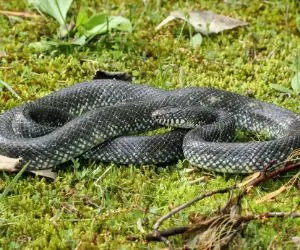
- Experience Level: Beginner to intermediate
- Family: Colubridae
- Scientific Name: Lampropeltis nigra
- Other Names: Mexican black kingsnake
- Adult Size: 24-48 inches (60.96-121.92 centimeters)
- Lifespan: 10-20 years
- Average Price Range: $79-$100
Any snake in the genus, Lampropeltis, is considered a kingsnake or milk snake. The five that reside in Mississippi are the black kingsnake, eastern milk snake, scarlet kingsnake, speckled-kingsnake, and yellow-bellied kingsnake.
Black kingsnakes are stocky, black snakes with yellowish spots. They are common throughout much of Mississippi but prefer forests, farms, and palustrine wetlands. Black kingsnakes eat other snakes and rodents.
2. Black racer
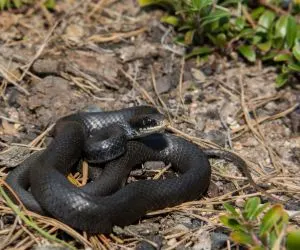
- Experience Level: Expert
- Family: Colubridae
- Scientific Name: Coluber constrictor
- Other Names: Runner
- Adult Size: 36-48 inches (91.44-121.92 centimeters)
- Lifespan: 15-20 years
- Average Price Range: $40-$80
This speedy serpent resides throughout the state of Mississippi. In all places but the Delta, they’re black. In the Delta, they’re more of a blue color.
Racers can be seen crossing the roads quite often and aren’t picky about what they feed on, eating anything from rodents to insects to other snakes.
3. Brown snake
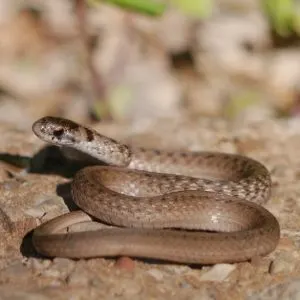
- Experience Level: Beginner
- Family: Colubridae
- Scientific Name: Storeria dekayi dekayi
- Other Names: De Kay’s snake
- Adult Size: 9-20 inches (22.86-50.8 centimeters)
- Lifespan: ~7 years
- Average Price Range: $30
Brown snakes, also known as De Kay’s snake (after American zoologist James Ellsworth De Kay), are small brown, nonvenomous snakes that reside throughout the entire state of Mississippi.
Usually found in lawns, gardens, and fields, these brownish yellow snakes are no strangers to human beings, often living in urban and suburban areas. They even make great small pets. Brown snakes feed largely on slugs, snails, and earthworms.
4. Diamondback watersnake
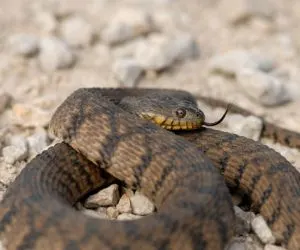
- Experience Level: Intermediate to Expert
- Family: Colubridae
- Scientific Name: Nerodia rhombifer
- Other Names: N/A
- Adult Size: 20-36 inches (50.8-91.44 centimeters)
- Lifespan: 7-10 years
- Average Price Range: $50
The United States is home to nine watersnake species, and Mississippi hosts six of them: the diamondback watersnake, northern watersnake, saltmarsh snake, Mississippi green watersnake, plain-bellied watersnake, and southern watersnake.
The diamondback watersnake is predominantly brown or green with a black diamond pattern along its back. All six species of watersnakes in Mississippi generally live by slow-moving waters such as rivers, streams, ponds, and swamps.
Boaters beware as watersnakes love to bask in low-hanging tree branches! Fish and amphibians make up the bulk of a watersnake’s diet.
5. Eastern coachwhip snake

- Experience Level: Expert
- Family: Colubridae
- Scientific Name: Masticophis flagellum
- Other Names: N/A
- Adult Size: 50-72 inches (127-182.88 centimeters)
- Lifespan: 12-20 years
- Average Price: $100
Eastern coachwhip snakes are noticeably absent from the Mississippi Delta as the region divides this species’ range into two separate groupings. However, they are present in the rest of the state, especially in marshy areas.
Eastern coachwhips are slender, tan snakes that often have a black head and neck. They resemble a whip, hence the name. The eastern coachwhip’s diet consists of birds, insects, lizards, small mammals, and other snakes.
6. Eastern milk snake
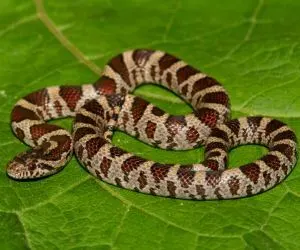
- Experience level: Beginner
- Family: Colubridae
- Scientific name: Lampropeltis triangulum
- Other names: Chicken snake, kingsnake
- Adult Size: 24-36 inches (60-91 centimeters)
- Lifespan: 10-15 years
- Average Price Range: $60-$120
Out of the five snakes with the genus, Lampropeltis, in Mississippi, the eastern milk snake and the scarlet kingsnake look the most like the coral snake. Like we already touched on, DO NOT confuse them with the extremely venomous coral snake.
Opposed to the coral snake, milk snakes make for great pets, and that’s coming from a former kingsnake owner. They have a circular pattern of red, black, and creamy bands and are typically found in woodland habitats.
Their diet mainly consists of small mammals, small birds, and sometimes other small snakes.
7. Eastern ribbon snake
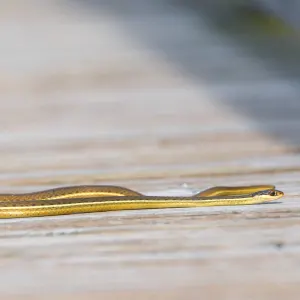
- Experience Level: Beginner
- Family: Colubridae
- Scientific Name: Thamnophis sauritus
- Other Names: N/A
- Adult Size: 16-35 inches (41-89 centimeters)
- Lifespan: 12-20 years
- Average Price Range: $40
The eastern ribbon snake mostly lives in aquatic areas with high vegetation such as creek-beds, streams, and lakes. They are dark with yellow stripes and aren’t the only ribbon snake to reside in Mississippi as the western ribbon snake also calls the Magnolia State home.
Similar to garter snakes, ribbon snakes refuse to eat warm-blooded prey. Therefore, their diet mainly consists of newts, salamanders, frogs, toads, fish, and spiders.
8. Eastern wormsnake
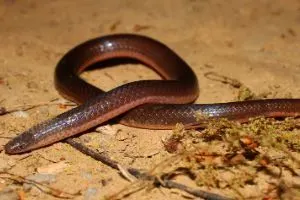
- Experience Level: Beginner
- Family: Colubridae
- Scientific Name: Carphophis amoenus amoenus
- Other Names: N/A
- Adult Size: 7.5-11 inches (19-28 centimeters)
- Lifespan: 4 years
- Average Price Range:$20
The eastern wormsnake inhabits forested areas everywhere in Mississippi except for the Delta region. Quite similar to the earthsnake outside of their scales, the eastern wormsnake is a very small and thin brown snake that lives primarily in forested habitats.
Also fossorial, they only eat earthworms. Consider yourself lucky if you ever see a wormsnake above ground!
9. Glossy crayfish snake

- Experience Level: Intermediate
- Family: Colubridae
- Scientific Name: Regina rigida
- Other Names: The stiff snake
- Adult Size: 14-24 inches (35.56-60.96 centimeters)
- Lifespan: ~7 years
- Average Price Range: $40
Yes, the primary food source for the glossy crayfish snake is…you guessed it, crayfish! Glossy crayfish snakes are small, semiaquatic snakes with two faint stripes running down the length of their glossy brown bodies.
10. Gray crayfish snake
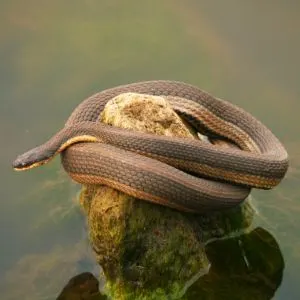
- Experience Level: Intermediate
- Family: Colubridae
- Scientific Name: Regina grahamii
- Other Names: N/A
- Adult Size: 18-28 inches
- Lifespan: ~7 years
- Average Price Range: $50
Yes again, the main food source for the gray crayfish snake is also crayfish. Both the glossy and the gray crayfish snakes have chisel-like teeth in order to get through the hard shell of a mudbug.
The main difference between the gray and the glossy crayfish snakes is the coloration. Gray crayfish snakes are…well, gray.
11. Indigo snake
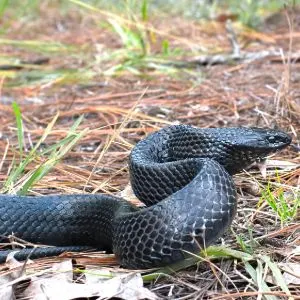
- Experience Level: Expert
- Family: Colubridae
- Scientific Name: Drymarchon couperi
- Other Names: Blue gopher snake
- Adult Size: 55-102 inches (139.7-259.08 centimeters)
- Lifespan: 11-21 years
- Average Price Range: $1,500-$3,000
An absolutely beautiful snake, the indigo snake is an easy snake to identify. Along with its blue hue, indigo snakes are considered the largest colubrids. They live in the southeast, coastal corner of the state and feed mainly upon other snakes, turtles, mammals, frogs, birds, and lizards.
12. Mississippi green watersnake
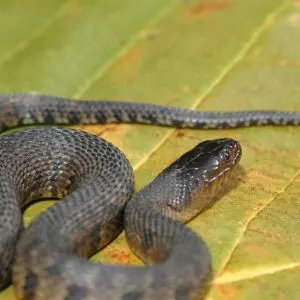
- Experience Level: Intermediate
- Family: Colubridae
- Scientific Name: Nerodia cyclopion
- Other Names: N/A
- Adult Size: 30-45 inches (76.2-114.3 centimeters)
- Lifespan: N/A
- Average Price Range: N/A
The coloration of a Mississippi green watersnake is pretty straightforward as they are typically green with occasional markings that disappear as they age.
Like the other five watersnake species, Mississippi green watersnakes prefer slow-moving bodies of water and eat fish, amphibians, and crayfish.
13. Mud snake
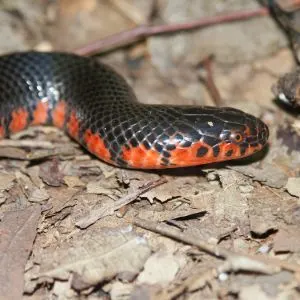
- Experience Level: Expert
- Family: Colubridae
- Scientific Name: Farancia abacura
- Other Names: Stinging snake
- Adult Size: 40-65 inches (101.6-165.1 centimeters)
- Lifespan: 19 years
- Average Price Range: $90
Two snakes in the genus, Farancia, live in Mississippi: the mud snake and the rainbow snake. Not seen often by humans as they usually reside in the muddiest of waters the state has to offer, mud snakes primarily rely on sirens and salamanders as their main source of food.
This species is black on the top and red on the bottom.
14. Northern watersnake
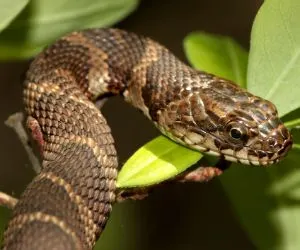
- Experience Level: Intermediate
- Family: Colubridae
- Scientific Name: Nerodia sipedon
- Other Names: Common watersnake
- Adult Size: Up to 32-35 inches (81.28-88.9 centimeters)
- Lifespan: 9 years
- Average Price Range: $30
The northern watersnake can be gray, red, brown, or black, and it has dark crossbands on the neck. It also may have blotches down the rest of the body. These snakes can be found either along the water or in muskrat houses and beaver lodges.
Northern watersnakes eat fish, worms, leeches, crayfish, small mammals, and small birds.
15. Pine woods snake
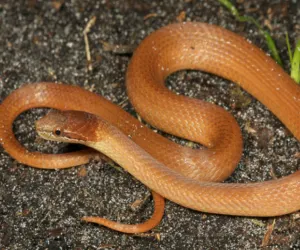
- Experience Level: N/A
- Family: Colubridae
- Scientific Name: Rhadinaea flavilata
- Other Names: Yellow-lipped snake
- Adult Size: 10-13 inches (25-33 centimeters)
- Lifespan: 1-3 years
- Average Price Range: N/A
Pine woods snakes primarily live in the lowermost portion of the Pine Belt, as well as the coastal region. Their fully reddish-brown bodies allow them to easily blend in with their environment.
Not much is known about pine woods snakes except for the facts that they’re not only fossorial but have been seen to feast on small frogs, salamanders, and lizards.
16. Plain-bellied watersnake
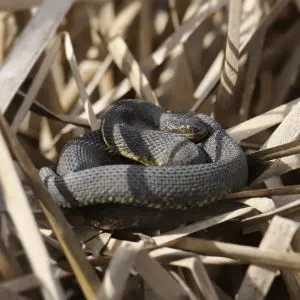
- Experience Level: Intermediate
- Family: Colubridae
- Scientific Name: Nerodia erythrogaster
- Other Names: Plainbelly watersnake
- Adult Size: 24-40 inches (88.9-101.6 centimeters)
- Lifespan: 8-15 years
- Average Price Range: $40
The plain-bellied watersnake’s name comes from its pattern-less underside. They are usually brown, green, or gray with darker blotching down the back. Its underside can be yellow, brown, green, or gray. They primarily eat crawfish, fish, and amphibians.
17. Rainbow snake
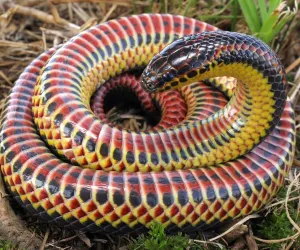
- Experience Level: Expert
- Family: Colubridae
- Scientific Name: Farancia erytrogramma
- Other Names: Eel moccasins
- Adult Size: 36-48 inches (91.44-121.92 centimeters)
- Lifespan: 12-19 years
- Average Price Range: N/A
The second of the two Mississippi snakes in the genus, Farancia, rainbow snakes also mainly consume water-based amphibians and live in the muddy waters of ponds, creeks, and swamps.
The main difference between the mud snake and the rainbow snake is the red lines that go down the course of the rainbow snake’s body, occasionally giving off a rainbow feel.
18. Red-bellied snake
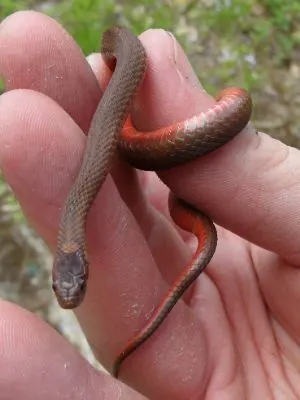
- Experience Level: Intermediate
- Family: Colubridae
- Scientific Name: Storeria occipitomaculata
- Other Names: Fire snake
- Adult Size: 4-10 inches (10-25 centimeters)
- Lifespan: 4 years
- Average Price Range: $60
The red-bellied snake is a woodland snake that resides in both southern Mississippi, as well as the northeastern corner of the state. They are not to be found in central Mississippi.
This species can vary in color. However, they all have an unmarked red or orange underside, which makes them easily recognizable. If it’s not a slug, they probably won’t eat it.
19. Rough earthsnake
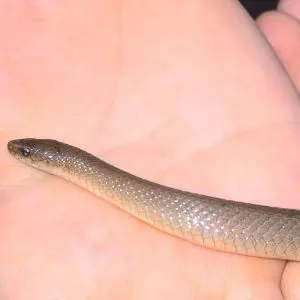
- Experience Level: Expert
- Family: Colubridae
- Scientific Name: Haldea striatula
- Other Names: Brown ground snake
- Adult Size: 7-10 inches (17.78-25.4 centimeters)
- Lifespan: 7 years
- Average Price Range: N/A
The rough earthsnake is very similar to wormsnakes (small and brown to gray in color).
However, the only difference is that rough earthsnakes have keeled scales. Rough earth snakes live in forested areas all over the state of Mississippi. They feed exclusively on earthworms.
20. Rough green snake
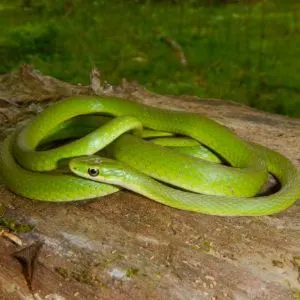
- Experience Level: Beginner
- Family: Colubridae
- Scientific Name: Opheodrys aestivus
- Other Names: Grass snake, green grass snake
- Adult Size: up to 32 inches (81 centimeters)
- Lifespan: Up to 15+ years
- Average Price Range: $30
Rough green snakes live in a variety of habitats throughout Mississippi, from wetlands to open forests. These slender, lime green snakes with yellow bellies are easily distinguishable and make for a good pet for beginners.
Rough green snakes also rely heavily on vegetation to camouflage in. They primarily feed on crickets, caterpillars, and grasshoppers.
21. Saltmarsh snake

- Experience Level: Intermediate
- Family: Colubridae
- Scientific Name: Nerodia clarkii
- Other Names: N/A
- Adult Size: 15-30 inches (38-76 centimeters)
- Lifespan: Up to 20 years
- Average Price Range: $130
The most saltwater-oriented of the six watersnake species in Mississippi, the saltmarsh snake tends to live along the Mississippi Gulf Coast and its barrier islands. The saltmarsh snake is the only representative of the Nerodia genera that is striped.
It usually has two dark stripes and two lighter-colored stripes. They typically prey on frogs, shrimp, crabs, and crayfish.
22. Scarlet kingsnake
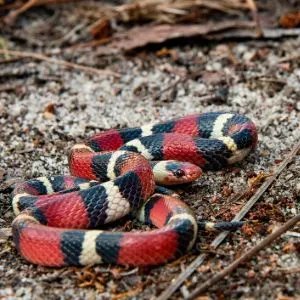
- Experience level: Beginner to intermediate
- Family: Colubridae
- Scientific name: Lampropeltis
- Other names: N/A
- Adult Size: 14-20 inches (36-51 centimeters)
- Lifespan: 20-30 years
- Average Price Range: $60-$120
Like the milk snake, the scarlet kingsnake looks very similar to a coral snake (Remember: yellow and red bands separated by black = nonvenomous). Scarlet kingsnakes cover every inch of Mississippi, typically feeding on lizards and small snakes.
23. Smooth earthsnake
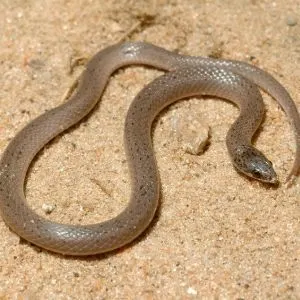
- Experience Level: Intermediate
- Family: Colubridae
- Scientific Name: Virginia valeriae
- Other Names: N/A
- Adult Size: 7-10 inches (18-25.4 centimeters)
- Lifespan: 9-10 years
- Average Price Range: N/A
The only representative of the Virginia genera in Mississippi, the smooth earthsnake is fairly common in east Mississippi. Most individuals are brown to gray and somewhat shiny, giving off the smooth-looking appearance.
They can be found in a variety of forested and edge habitats. These fossorial snakes primarily feed on earthworms, insects, and insect larvae.
24. Southeastern crowned snake
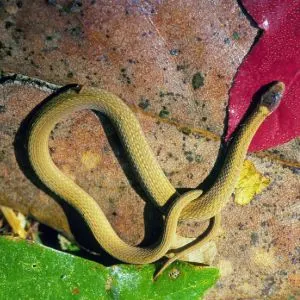
- Experience Level: N/A
- Family: Colubridae
- Scientific Name: Tantilla coronata
- Other Names: Southeastern black-headed snake
- Adult Size: 5.2-9.6 inches (13.3-24.5 centimeters)
- Lifespan: N/A
- Average Price Range: N/A
The southeastern crowned snake can be found throughout all of Mississippi except for the upper Delta region. A very tiny snake, adults are normally brown with a black head that represents a “crown.” This species feeds only on insects, insect larvae, snails, spiders, and centipedes.
25. Southern hognose
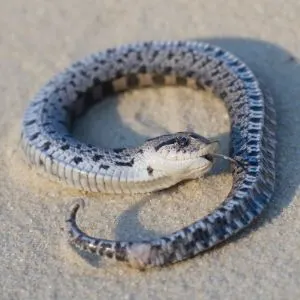
- Experience Level: Beginner to Intermediate
- Family: Colubridae
- Scientific Name: Heterodon simus
- Other Names: Hissing adder, blow viper
- Adult Size: Up to 24 inches (60.96 centimeters)
- Lifespan: 5 years
- Average Price Range: $200
The southern hognose is one of the cutest snakes that Mississippi has to offer. With its pig-like nose and small body, it’s natural to want one of these guys as a pet. Trust me from experience. They will hiss and geek a lot until they get comfortable with you.
Once they’re comfortable, though, they’re awesome pets. Southern hognose snakes can only be found in the southernmost portion of Mississippi and usually eat frogs, toads, and small lizards.
26. Southern watersnake

- Experience Level: Intermediate
- Family: Colubridae
- Scientific Name: Nerodia fasciata
- Other Names: Banded watersnake
- Adult Size: 24-42.1 inches (61-107 centimeters)
- Lifespan: N/A
- Average Price Range: $50
You’ve probably noticed that the experience level designated for all six of the watersnake species in Mississippi is “intermediate.” Surprisingly enough, watersnakes make for great pets as they don’t require too much care and rarely bite.
Just remember to keep a fairly large container of water at one end of the terrarium! The southern watersnake is usually greenish-gray or brown with flat heads and heavy bodies. They also mainly eat fish and amphibians.
27. Speckled kingsnake
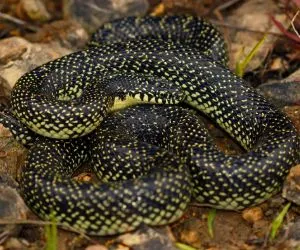
- Experience Level: Beginner to intermediate
- Family: Colubridae
- Scientific Name: Lampropeltis holbrooki
- Other Names: Salt and pepper snake
- Adult Size: 36-70 inches (91.44-177.8 centimeters)
- Lifespan: 10-20 years
- Average Price Range: $99-$200
Considered by many Mississippians as a ‘good snake,’ speckled kingsnakes are not only gorgeous but they eat venomous snakes. Completely black with white or yellow spots, speckled kingsnakes are easily identifiable.
It doesn’t matter where you live in Mississippi, you can run across one of these snakes. Their diet consists of other snakes, birds, rodents, and lizards.
28. Western ribbon snake
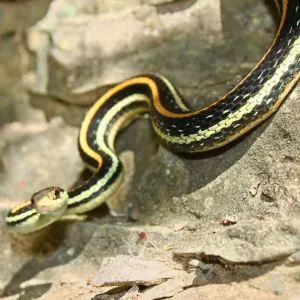
- Experience Level: Beginner
- Family: Colubridae
- Scientific Name: Thamnophis proximus
- Other Names: N/A
- Adult Size: 17-50 inches (43-127 centimeters)
- Lifespan: 12-20 years
- Average Price Range: $40
Ah, the other ribbon snake that resides in Mississippi is the western ribbon snake. Like its counterpart in the eastern ribbon snake, the western ribbon snake is also dark with yellow stripes.
They also have pretty much the same diet as the eastern ribbon snake—fish, frogs, toads, salamanders, et cetera. The only difference between the eastern and the western ribbon snakes is that the western ribbon snake oftentimes has two white spots on the top of their heads.
Eastern ribbon snakes will never have the two white spots.
29. Yellow-bellied kingsnake

- Experience Level: Beginner to intermediate
- Family: Colubridae
- Scientific Name: Lampropeltis calligaster
- Other Names: Prairie kingsnake
- Adult Size: 24-42 inches (60.96-106.68 centimeters)
- Lifespan: 12-16 years
- Average Price Range: $160
The last of the five Mississippi snakes in the genus, Lampropeltis, the yellow-bellied kingsnake is everywhere in Mississippi. These kingsnakes are brown with shiny, smooth scales and a yellowish belly.
Typically found in forests, yellow-bellied kingsnakes prey on mice, voles, lizards, and other snakes.
30. Queen snake
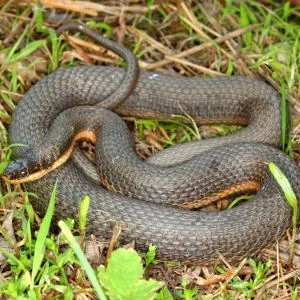
- Experience Level: Beginner to Intermediate
- Family: Colubridae
- Scientific Name: Regina septemvittata
- Other Names: Moon snake, striped water snake
- Adult Size: 13.4-36.3 inches (34-92.2 centimeters)
- Lifespan: 12-19 years
- Average Price Range: $35
As you’ve probably come to find out, Mississippi is rich in kingsnakes, so why not have a queen snake? The queen snake primarily lives along the Mississippi-Alabama border and is a slender, semiaquatic snake that can be found in lakes and ponds.
The queen snake is olive, gray, or brown and has two yellow stripes that run down its length at the first scale. These snakes also have four brown ventral stripes, which is key to identifying them. Queen snakes subsist on crawfish, tadpoles, minnows, and fairy shrimp.
Venomous Snakes in Mississippi
31. Canebrake rattlesnake
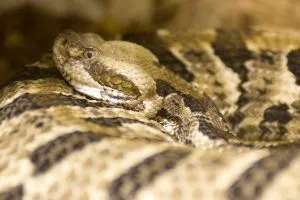
- Experience Level: Expert
- Family: Viperidae
- Scientific Name: Crotalus horridus
- Other Names: Timber rattler, velvet-tailed rattler
- Adult Size: 36-54 inches (91.44-137.16 centimeters)
- Lifespan: 10-20 years
- Average Price Range: $150
Outside of the coastal region, canebrake rattlesnakes are prominent throughout the entire state of Mississippi, inhabiting forest and river bottoms. Their ground color is typically gray to tan with a pinkish wash and wavy black bands that cross the body.
Other features include a red line that runs down their spine and, of course, the rattle. The canebrake rattlesnake’s diet mainly consists of small rodents such as mice, rats, squirrels, and chipmunks.
32. Copperhead
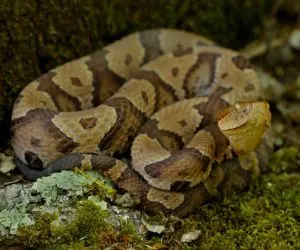
- Experience Level: Expert
- Family: Viperidae
- Scientific Name: Agkistrodon contortrix
- Other Names: Highland moccasin, rattlesnake pilot
- Adult Size: 24-36 inches (60.96-91.44 centimeters)
- Lifespan: ~18 years
- Average Price Range: $100
Copperheads inhabit the entire state except for the coast and its barrier islands. They favor hardwood forests but are also found in pine country, grass fields, bottomlands, and even some neighborhoods.
Typically gray or beige with dark brown hourglass-shaped crossbands, copperheads have a thick dark line that runs from their eye to the corner of their mouth.
They rarely have copper-colored heads, in opposition of their name. Copperheads eat rodents, small birds, lizards, frogs, and cicadas.
33. Coral snake
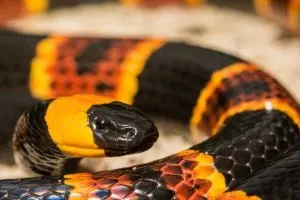
- Experience Level: Expert
- Family: Elapidae
- Scientific Name: Micrurus fulvius
- Other Names: N/A
- Adult Size: 24-36 inches (60.96-121.92 centimeters)
- Lifespan: 7-10 years
- Average Price Range: $250-$500
Coral snakes are beautiful snakes, but do not mistake them for a scarlet kingsnake.
While kingsnakes are fantastic pets, coral snakes ARE NOT as they are quite venomous (Quick tip: the yellow and red bands of coral snakes touch, while the yellow and red bands of kingsnakes will always be separated by black).
Coral snakes live in the sandy pinewoods of the southeastern portion of the state and can also sometimes be found along the beach. They typically eat other small snakes, as well as lizards.
34. Cottonmouth
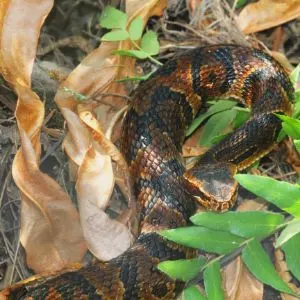
- Experience Level: Expert
- Family: Viperidae
- Scientific Name: Agkistrodon piscivorus
- Other Names: Water moccasin, stump-tailed moccasin
- Adult Size: 30-48 inches (76.2-121.92 centimeters)
- Lifespan: Up to 10 years
- Average Price Range: $150
If you’re from Mississippi, you probably refer to one of these snakes as a “water moccasin.” Cottonmouths live in every, single part of the state and tend to frequent creeks, swamps, bayous, and other aquatic areas.
They are brown to khaki-green with darker, wavy crossbands. Some cottonmouths, specifically in the Delta, are extremely dark. When threatened, the snake widely opens its “cotton-white” mouth.
Of the 135 venomous snakebites per year in Mississippi, the majority come from cottonmouths. Cottonmouths feed on fish, frogs, other snakes, small birds, and small mammals.
35. Eastern diamondback rattlesnake
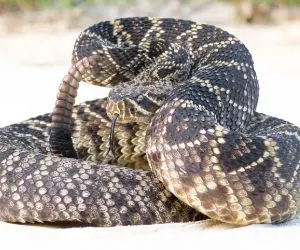
- Experience Level: Expert
- Family: Viperidae
- Scientific Name: Crotalus adamanteus
- Other Names: N/A
- Adult Size: 48-66 inches (121.92-167.64 centimeters)
- Lifespan: 15-20 years
- Average Price Range: N/A
The largest rattlesnake in the state of Mississippi, the eastern diamondback rattlesnake is easily recognizable. Their color is brown or tan with darker, diamond-shaped markings and a rattle on their tail. Eastern diamondbacks live solely in the southeastern portion of the state.
However, they are not as populous as they once were due to habitat destruction, which has spurred many people to believe the species should be protected. Eastern diamondbacks have a specific diet made up of large rodents and rabbits.
36. Pygmy rattlesnake
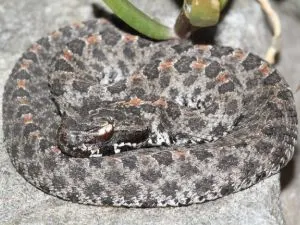
- Experience level: Expert
- Family: Viperidae
- Scientific Name: Sistrurus miliarus
- Other Names: Ground rattler
- Adult Size: 18-20 inches (45.72-50.8 centimeters)
- Lifespan: +20 years
- Average Price Range: $120
Pygmy rattlesnakes are dark snakes with even darker spots that travel down the course of their spine. In comparison to other rattlesnakes, which typically have randomly arranged scales on their head, pygmy rattlesnakes have nine symmetrically arranged scales on their head.
If you ever see what you believe to be a pygmy rattlesnake but you can’t spot a rattle, chances are it’s still a pygmy rattlesnake as their small rattles are often broken off. Besides a bulk of the Delta, this species can be found in flatwoods, forests, and swamps all across the state.
They feed on other small snakes, lizards, frogs, and mice.
Frequently Asked Questions
Can you own a snake in Mississippi?
Mississippi § 49-8-5 prohibits animals that are “inherently dangerous” to humans from being one’s pet without a permit. However, snakes are not listed. So yes, you can technically own a snake in the state of Mississippi.
What venomous snakes live in Mississippi?
There are six venomous snakes in Mississippi: canebrake rattlesnake, copperhead, coral snake, cottonmouth, eastern diamond rattlesnake, pygmy rattlesnake. The best way to identify venomous snakes is to learn their identifying characteristics.
Can you kill snakes in Mississippi?
In the state of Mississippi, you can legally kill a snake—venomous or nonvenomous—if it’s on your property. You can legally kill a venomous snake on any property if it is posing an imminent threat to you.
To kill one that’s not on your property, you will need a small game hunting license from the Mississippi Department of Wildlife, Fisheries, and Parks (MDWFP).
Also, per the MDWFP, don’t forget that it’s illegal to kill any protected endangered species in the state of Mississippi and that includes the rainbow snake, ringed sawback, yellow-blotched sawback, and the southern hognose.
Conclusion
From Corinth to the capital and to the coast, snakes are EVERYWHERE in Mississippi. Thanks for reading, and we hope this list of snakes in Mississippi helps you out—whether you’re looking to herp or for a new pet.
Feel free to comment below and discuss Mississippi’s snakes with fellow enthusiasts.
Snakes in other states
